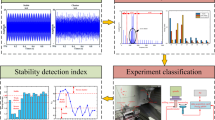Abstract
This paper presents an advance in chatter detection in ball end milling process. The dynamic cutting forces are monitored by utilizing the wavelet transform. The new three parameters are introduced to classify the chatter and the non-chatter by taking the ratio of the average variances of dynamic cutting forces to the absolute variances of themselves. The Daubechies wavelet is employed in this research to analyze the chatter. The experimental results showed that the chatter frequency occurred in the different levels of wavelet transform due to the different cutting systems. The new algorithm is developed to detect the chatter during the in-process cutting. The experimentally obtained results showed that the chatter can be easier to detect referring to the proposed parameters under various cutting conditions.













Similar content being viewed by others
References
Addison, P. S. (2002). The illustrated wavelet transform handbook, introductory theory and applications in science, engineering, medicine and finance. Institute of Physics Publishing Bristol and Philadelphia.
Altintas, Y., & Budek, E. (1995). Analytical prediction of stability lobes in milling. Annals of the CIRP, 44(1), 357–362.
Altintas, Y., & Lee, P. (1998). Mechanics and dynamics of ball end milling transactions of ASME. Journal Manufacturing Science and Engineering, 120, 684–692.
Altintas, Y., & Park, S. S. (2004). Dynamic compensation of spindle-integrated force sensors. Annals of the CIRP, 53(1), 305–308.
Bickraj, K., Kaya, B., Yapici, A., Li, M., Tansel, I. N., & Ozcelik, B. (2007). Inspection of chatter damage in end milling operations by using wavelet transformations. In 5th international Latin American and Caribbean conference for engineering and technology. Tempaco, Mexico.
Graps, A. (1995). An introduction to wavelets. Computational Science & Engineering, IEEE, 2(2), 50–61.
Kwak, J. (2005). Application of wavelet transform technique to detect tool failure in turning operations. The International Journal of Advanced Manufacturing Technology, 28(11), 1078–1083.
Kuljanic, E., Totis, G., & Sortino, M. (2009). Development of an intelligent multisensor chatter detection system in milling. Mechanical Systems and Signal Processing, 23(5), 1704–1718.
Quintana, G., Garcia, R. M. L., & Ciurana, J. (2011). Surface roughness monitoring application based on artificial neural network for ball-end milling operation. Journal of Intelligent Manufacturing, 22, 607–617.
Rubio, E. M., & Teti, R. (2009). Cutting Parameters analysis for the development of a milling process monitoring system based on audible. Journal of Intelligent Manufacturing, 20, 43–54.
Somkiat, T. (2011). Advanced in detection system to improve the stability and capability of CNC turning process. Journal of Intelligent Manufacturing, 22, 843–852.
Somkiat, T. (2012). Analysis of chatter in ball end milling by wavelet transform. World Academy of Science, Engineering and Technology, 71, 1075–1081.
Somkiat, T., & Narongsak, P. (2013). Development of chatter detection in milling processes. The International Journal of Advanced Manufacturing Technology, 65(5), 919–927.
Tansel, I. N., Alexander, T., & Wagiman, A. (1993). Modeling workpiece vibration with neural networks. Journal of Intelligent Manufacturing, 4, 95–107.
Tansei, I. N., Demetgul, M., Bickraj, K., Kaya, B., & Ozcelik, B. (2013). Basic computational tools and mechanical hardware for toque-based diagnostic of machining operations. Journal of Intelligent Manufacturing, 24, 147–161.
Tarng, Y. S., & Chen, M. C. (1994). An intelligent sensor for detection of milling chatter. Journal of Intelligent Manufacturing, 5, 193–200.
Xiaoli, L., Dong, S., & Zhejun, Y. (1999). Discrete wavelet transform for tool breakage monitoring. International Journal of Machine Tools and Manufacture, 39, 1935–1944.
Yao, Z., Mei, D., & Chen, Z. (2010). On-line chatter detection and identification based on wavelet and support vector machine. Journal of Materials Processing Technology, 210(5), 713–719.
Yoon, M. C., & Chin, D. H. (2005). Cutting force monitoring in the endmilling operation for chatter detection. Proceedings of the Institution of Mechanical Engineers, Part B: Journal of Engineering Manufacture, 219(6), 455–465.
Zuperl, U., Cus, F., & Reibenschuh, M. (2012). Modeling and adaptive force control of milling by using artificial technique. Journal of Intelligent Manufacturing, 23, 1805–1815.
Acknowledgments
This research was performed and supported by The Asahi Glass Foundation, Japan from 2010 to 2011.
Author information
Authors and Affiliations
Corresponding author
Rights and permissions
About this article
Cite this article
Tangjitsitcharoen, S., Saksri, T. & Ratanakuakangwan, S. Advance in chatter detection in ball end milling process by utilizing wavelet transform. J Intell Manuf 26, 485–499 (2015). https://doi.org/10.1007/s10845-013-0805-3
Received:
Accepted:
Published:
Issue Date:
DOI: https://doi.org/10.1007/s10845-013-0805-3




